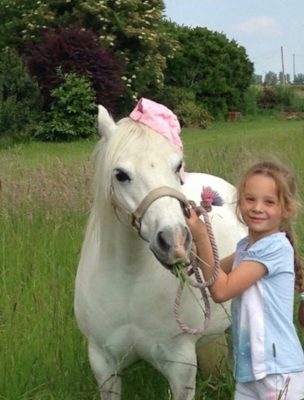The heartbroken owner of a pony who was put down after after eating woodchip from a poisonous tree has urged others to be aware when buying wood products.
Tracey Wingert’s daughters’ ponies, Jim a 11.1hh part-bred welsh, and Dram a part-bred hackney, became ill shortly after eating woodchip that had been put down on their outdoor paddock on the morning of 15 January.
“We let the ponies out after their breakfast and they were very excited; rolling and digging the woodchip. I returned at midday to muck out and Jim didn’t seem himself; he was standing with his head down looking really sorry for himself. He went down on the floor and when I got him back up he was kicking his belly and swishing his tail,” Tracey told H&H.
“Jim can be a greedy little Welsh and I think he must have had a good munch on the wood chip – I thought he’d come down with colic. I phoned the vet and they said to keep him walking until they arrived. He kept going down and I’d get him back up but then I saw Dram began showing symptoms of being uncomfortable too. I thought you don’t get two ponies showing the same symptoms, what’s going on?”
Tracey’s husband Lee contacted the company which supplied the woodchip and was told it came from the false acacia tree.
“I looked the tree up online and found it was poisonous to horses. The vet arrived and said he had only seen that type of poisoning in cattle before and hadn’t heard of it in horses,” said Tracey.
“Jim’s temperature and heart rate were low but he didn’t have gut sounds which the vet said was concerning. The vet gave both Jim and Dram an injection and Jim was given fluids and liquid paraffin and seemed to pick up.”
Tracey spent the rest of the day checking the ponies but Jim’s condition deteriorated by late in the evening.
“My youngest daughter Lily, 12, went outside to say goodnight to Jim before she went to bed and she phoned inside to say Jim was breathing funny — he was heaving,” she said. “I phoned the vet who asked me to send a video, she thought he was possibly just uncomfortable again and to give him some bute and see how he was.

“I stayed with Jim until 12.30am when I went inside for 10 minutes while my husband stayed with him and in that time Jim went down. We called the vet who arrived 45 minutes later. The vet was happy it wasn’t colic but did a rectal examination and put a tube down his nose, these were fine and the vet said she was baffled.”
The vet said Jim should be admitted to the equine hospital more than an hour and a half away but he was too unwell to travel.
“My initial reaction was I didn’t think he would make the journey and so it was agreed to fit a cannula and put a tube down his nose and give fluids to try and make him strong enough to travel later. It took the vet 25 minutes to get the cannula in because his blood pressure was so low and everything was shutting down, it was horrendous,” said Tracey.
Jim deteriorated and began to show signs of kidney failure and it was agreed to put him down at 3am.
“The vet listened to his heart and I could see it in her face. My husband and two eldest daughters were there but Lily was in bed. The vet said there wasn’t anything else we could do and he was put to sleep,” said Tracey.

Are buttercups poisonous to horses? We ask the experts…

5 common plants that could kill your horse
While many plants can be poisonous if eaten to excess, there are some poisonous plants that horses should avoid at

Subscribe to Horse & Hound magazine today – and enjoy unlimited website access all year round
“The next morning Lily got up for school and came running into our bedroom and said she was going to go and check on Jim and I had to ask her to come and sit on the bed to tell her but she already knew. It was heartbreaking – it absolutely destroyed her. She would spend every day with Jim – he was pampered into an inch of his life. He was the most loving pony, every morning he was the first to put his nose over the stable door. ”
Tracey said she wants others to be aware of false acacia poisoning.
“If you’re buying woodchip, check with the company what tree it is,” said Tracey. “It presented as colic symptoms so how many people could have lost horses and ponies because it was thought it was colic and not known it’s poisoning? If Dram hadn’t started showing signs too I would have thought it was just colic. Lily said to me she doesn’t want anyone else’s pony to go through this.”
For all the latest news analysis, competition reports, interviews, features and much more, don’t miss Horse & Hound magazine, on sale every Thursday.





